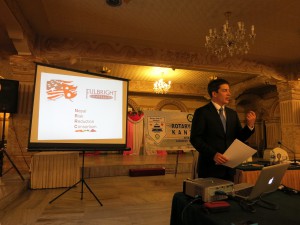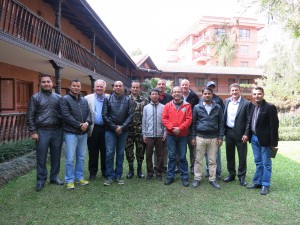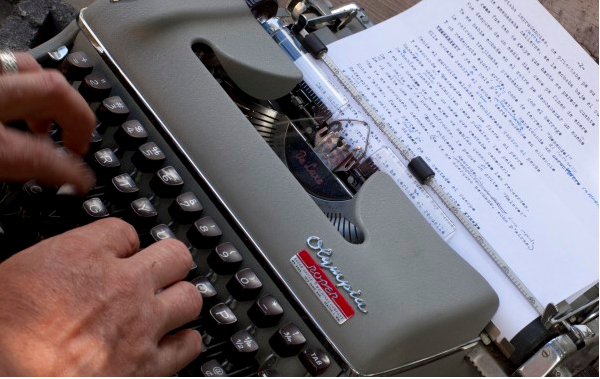
Daniel Trusilo, 2013-2014, J. William Fulbright – Hillary Rodham Clinton Fellow to Nepal (and West Point alumnus), giving a talk on disaster preparedness at the Rotary Club of Kantipur
Kyanjin Gompa is a small, remote village North of Kathmandu at the far end of Langtang Valley. Only now, weeks after the devastating earthquake that struck Nepal on April 25th has the level of destruction in Langtang become known. I spent several weeks of October last year in Langtang, staying with a Nepali family of five. Every morning Gyalbu, the father, would put a chair in the sun for me to sit on while I scribbled notes in a journal. Gyalbu’s wife, who I called DiDi, meaning older sister, would make delicious yak cheese and vegetable omelets for breakfast while their two daughters would sit on a bench playing with their Barbie dolls and their son would help with chores. Gyalbu and his wife were always generous with their smiles as the sun melted away the mountain chill and their children played happily in puffy down jackets.
I was repeatedly moved by the kindness of Gyalbu’s family who faced adversity without complaint. The remarkable thing is that the generosity and sense of community that I felt with this family was not an isolated event. Having spent the last year in Nepal as a J. William Fulbright – Hillary Rodham Clinton Public Policy Fellow, I witnessed the strong sense of community and boundless generosity of the Nepali people over and over again. When I was not working in an official capacity, I used the time to meet with community leaders via the extensive Rotary Club network across Kathmandu Valley. Discussions on disaster preparedness were an opportunity to meet leaders outside of work and advance disaster mitigation efforts. Community members from the Rotary network were always enthusiastic about improving Nepal in any small way that they could.

Group photo of the Search and Rescue Technical Working Group at the Nepal Armed Police Force Disaster Management Training Center
Before April’s earthquake, many people were unaware that Nepal has some of the highest risk of natural disasters in the world. Captivated by picturesque mountains and village life, tourists have passed through Nepal to places like Langtang unaware of the earthquake risk for years. However, the U.S. Mission in Nepal was well aware of the looming threat. My primary focus as a Fulbright-Clinton Public Policy Fellow was to advance policy related to national emergency response capability in collaboration with the government of Nepal. I built friendships with outstanding Nepali and international colleagues as we worked to see this priority progress. The effort led to tangible results including the creation of a search and rescue technical working group. The group was composed of government officials, Nepal Security Forces, Nepal Red Cross as well as an internationally recognized technical adviser. The importance of the bonds that the Search and Rescue Technical Working Group forged through cooperation in a sincere and transparent way, before the earthquake struck, cannot be understated. Unfortunately, the disaster preparedness work we were doing is now a matter of disaster response.
It is my sincere hope that the collaborative effort I was privileged to witness before the earthquake will continue. In this spirit I have been working to connect the Rotary Clubs of Kathmandu Valley with recognized international disaster response organizations. At the same time, Nepali colleagues in the United States, who are working day and night to inform the Nepali community abroad about what to expect and how they can help have been inspirational even as mainstream media attention fades. It will take years of sustained effort to recover from the devastation wrought by the earthquake of April 25th, 2015. Despite the monumental task ahead, I am hopeful. The Government of Nepal and international assistance coming to its aid – organizations as well as motivated individuals around the world – have the opportunity to write a new page in the history of disaster response.
Daniel participated in the Fulbright-Clinton Public Policy Fellowship after completing a dual degree master’s program with the University of St. Gallen, Switzerland and the Fletcher School at Tufts University. He had previously served in the U.S. Army after graduating from West Point. To learn more about the current situation in Nepal, click here and here.
If you’re a U.S. citizen and would like to learn more about the Fulbright-Clinton Fellowship, we encourage you to join tomorrow’s webinar offering an introduction to the program. To learn more, click here.



1 Comment
Dear Daniel,
Thanks so very much for posting. As a 20111 Fulbright Senior Scholar in Art/Nepal I was acutely aware of the potential for horrendous loss of material culture in Nepal, and experienced the “gentle” effects of the 2011 Sikkim quake in Patan. I also celebrate the magnificent efforts of the KVPT in protecting and preserving so many monuments through the Kathmandu valley–and the efforts of other wonderful Nepalis–who acknowledged this inevitability and prepared for it; the Patan Museum and Royal Palace stand as tributes to their work. I am very happy to know that Fulbright-Clinton Fellowship is focused on establishing and strengthening the international and inter-governmental cooperation and knowledge exchange that will accelerate and expand efforts to not only deal with the current aftermath of the 2015 earthquake, but advance preparation against future challenges!